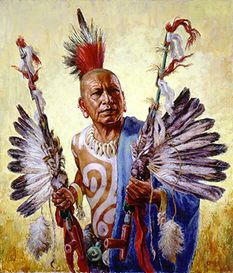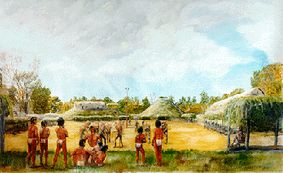|
The Quapaw Indians
by Carrie Wilson and George Sabo III Quapaw Indians lived in four villages near the confluence of the Arkansas and Mississippi Rivers when they were first contacted by the French explorers Marquette and Jolliet in 1673.
The Quapaws grew corn, beans, squash, pumpkins, gourds, and tobacco in fields near their villages. Fruits, nuts, seeds, and roots were collected. Deer, bear, and buffalo were hunted, and smaller mammals, wild turkeys, waterfowl, and fish were taken seasonally. After contact with Europeans, melons, peaches and chickens were raised. Quapaw women wore deerskin skirts and went topless during the warm seasons. Married women wore their hair loose, but unmarried women wore braids rolled into coils fastened behind each ear and decorated with ornaments. Men went naked or wore loincloths during the warm seasons. Leggings, moccasins, and robes were worn by both sexes during the cold seasons. The family was the basic unit of Quapaw social organization. Groups of families related through the males were joined into clans. Clans were named for animals, heavenly bodies, or natural phenomena like thunder. Clan members believed they were descended from a common ancestor that gave them a strong sense of shared identity and mutual obligation.
Villages consisted of rectangular houses arranged around an open area or plaza. Houses were constructed of parallel rows of long poles driven into the ground with tops bent over and tied together. Horizontal branches were interwoven among the uprights, and the framework was covered with bark sheets. Platforms covered with woven mats lined the interior walls and were used for sitting and sleeping. Central hearths provided heat and light. Each village also had a community building, built like a house but much larger, where people could assemble for meetings and ceremonies. Another structure, roofed but with open walls and a platform was also built near the plaza. Here leaders conducted public ceremonies and guests were received. Each village had a leader who was advised by a council of male elders. Villages managed their affairs independently, except when matters concerned the entire tribe. In these cases, decisions were made that involved the consent of all village leaders. Quapaw village life was ordered by ceremonies performed for important activities and events. Each clan had specific ceremonial duties. Some ceremonies, like those accompanying planting and harvesting activities, were scheduled according to season. Naming ceremonies, marriages, curing rituals, adoptions, and funerals were performed as needed. The Quapaws were close allies of the French in colonial Louisiana. During the subsequent Spanish regime, the Quapaws helped defend the colony from invasion by Indians allied with the English. The Quapaws tried to maintain their policy of peaceful coexistence when the United States purchased the Louisiana territory in 1803, but they were forced to surrender their Arkansas lands to the U.S. government in 1818 and 1824. A Quapaw reservation was established in 1839 in northeastern Oklahoma. Today, there are about 2,000 Quapaws, most of whom live near Miami, Oklahoma. Bibliography Baird, W. David
Davis, Hester A. (editor) Sabo III, George |

